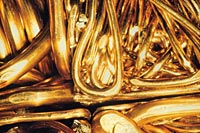Copper: Architecture’s Green ‘Enabler’
Mankind has been using copper for so long (about 10,000 years) and for so many purposes (ornaments, weapons, building materials, electronic components, etc.) that some might assume we'll soon run out of the stuff.
No need to worry. According to the U.S. Geological Survey, only a small percentage of all the world's known copper reserves have been recovered to date. Not only are there abundant reserves of this infinitely useful, attractive, reddish-brown metal, it's also virtually 100 percent recyclable—which means that almost all of the copper ever mined could, theoretically, still be in use. Practically speaking, many materials can be recycled that aren't. Copper benefits from a well developed recycling infrastructure and an economic value that drives recovery, recycling and reuse, especially of copper building products.
Copper has many attributes, but its environmental benefits make this unique metal especially desirable to architects, builders and organizations such as the United States Green Building Council (USGBC). In commercial and residential construction today, “green” is the new religion, and recyclability, recycled content, sustainability and energy efficiency are key. All of these happen to be among copper's most enduring features.
One of the principal tools employed by the green building movement is the USGBC rating system known as LEED, for Leadership in Energy and Environmental Design. The 14-year-old nonprofit organization has instituted LEED guidelines for residential and commercial construction, building operations and maintenance, core and shell development projects, and public and municipal buildings like schools.One critical LEED standard requires that newly constructed buildings include materials containing pre- and post-consumer recycled content. Copper provides a huge benefit in that most of the copper products used in construction (except certain electrical materials that require highly refined virgin copper) contain a large measure of recycled content.
Because copper is so recyclable, little is ever wasted. Many building products are made of pure copper or copper alloys that contain small amounts of other elements that are easily recycled. Typically, all copper scrap is reclaimed and reused, including finished products that are discarded after completing their consumer lifecycle.
Copper is also one of nature's most efficient thermal and electrical conductors, and it helps to conserve energy in many ways. In buildings, it is used extensively in heating systems, direct-exchange heat pumps, and solar power and hot water equipment because of its high thermal conductivity. It's high electrical conductivity increases the efficiency of lighting, electrical motors, fans and other equipment and appliances, making the building's operation more cost effective with less energy and environmental impact.
As green building principles continue to play a role in protecting the environment, copper will continue to make a significant contribution.
Also in this Issue:
- Copper: Architecture’s Green ‘Enabler’
- Copper: An Element of Good Design
- Copper Rx for Sick Buildings
- Austin City Hall Goes Green with Copper
- Cold Fusion: Joining Copper Plumbing Without Heat

 Reclaimed scrap copper for recycling.
Reclaimed scrap copper for recycling.